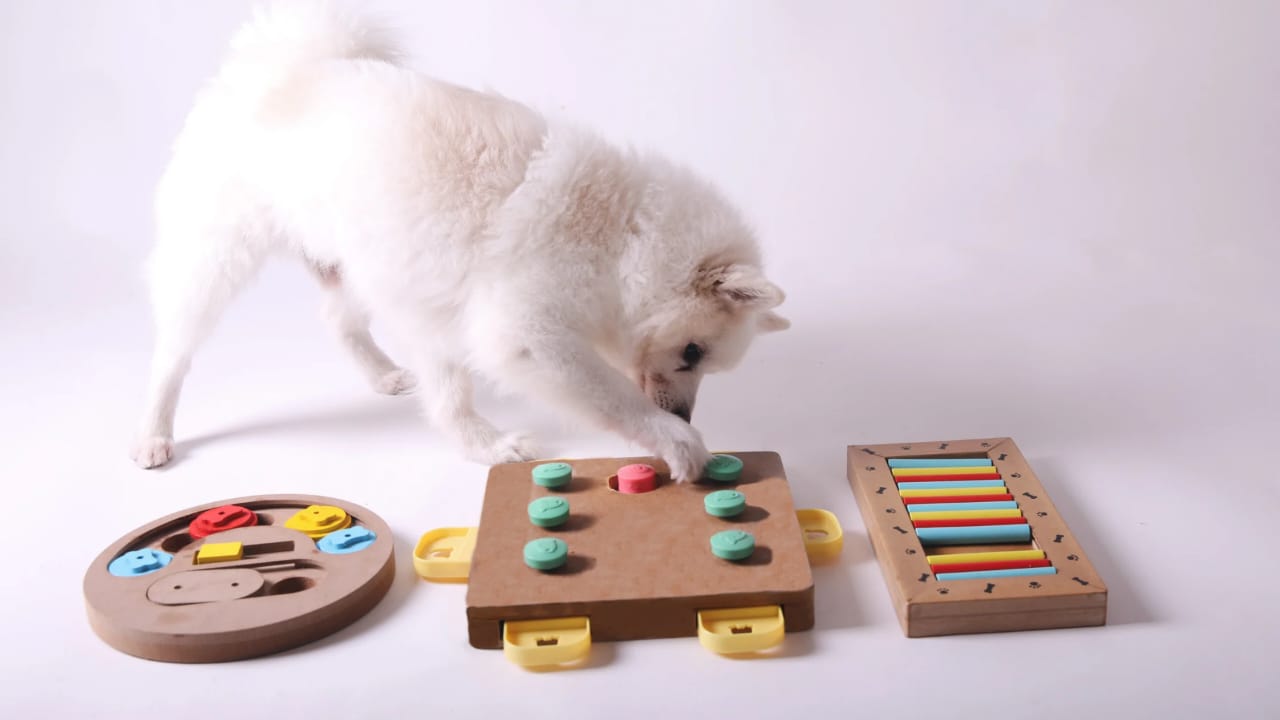Puzzles to Challenge a Dog’s Mind
Dogs are more than just loyal companions—they’re intelligent, curious creatures who thrive on mental stimulation. In 2025, as pet care continues to evolve, Puzzles to Challenge a Dog’s Mind are becoming a go-to solution for keeping our furry friends engaged and happy. Whether you’ve got a high-energy pup or a laid-back senior, these brain-teasing activities tap into their instincts, offering a fun way to ward off boredom and strengthen your bond. From DIY setups to store-bought toys, this article explores practical, expert-backed ways to spark your dog’s problem-solving skills.
I first stumbled into the world of canine puzzles when my scruffy terrier, Milo, started dismantling my couch cushions out of sheer restlessness. A vet friend suggested mental exercise over more walks, and soon, Puzzles to Challenge a Dog’s Mind became our daily ritual. What I discovered—and what science backs up—is that dogs need to flex their brains as much as their legs. Let’s dive into why these puzzles matter and how you can introduce them to your pup.
Why Mental Stimulation Matters for Dogs
Just like humans, dogs can get bored. A 2023 study from the American Kennel Club (AKC) found that mental enrichment reduces stress and destructive behavior in dogs by up to 40%. Physical exercise is crucial, but it’s the mental workout that keeps their minds sharp. Sniffing, searching, and solving problems mimic the tasks their wild ancestors tackled daily—hunting, foraging, and surviving. Without that challenge, modern dogs can turn to chewing shoes or barking at shadows.
Puzzles engage a dog’s senses and instincts. They encourage focus, boost confidence, and even tire them out more than a long walk might. For aging dogs, mental games can slow cognitive decline, much like crosswords do for humans. The best part? You don’t need a PhD in pet psychology to get started—just a little creativity and patience.
Start Simple: The Treat Hunt
One of the easiest ways to kick off Puzzles to Challenge a Dog’s Mind is a classic treat hunt. Grab some of your dog’s favorite kibble or small treats—something smelly works best—and hide them around the house. Start with obvious spots: under a cushion, behind a chair leg, or in a corner. Let your dog watch you at first, then gradually make it harder by hiding treats when they’re out of sight.
Milo went wild for this game. His tail wagged like a metronome as he sniffed out bits of chicken jerky I’d tucked into a rolled-up towel. Over time, I upped the ante—placing treats in empty tissue boxes or under overturned bowls. It’s a low-cost, high-reward puzzle that taps into their scent-driven nature. For tips on safe treat choices, check out the ASPCA’s guide to pet nutrition.
DIY Puzzle Toys You Can Make Today
You don’t need to splurge on fancy gadgets to challenge your dog. Household items can double as brain games with a little ingenuity. Take an old muffin tin, drop treats into a few slots, and cover them with tennis balls. Your dog will have to nudge the balls aside to score the goodies. It’s simple, but the problem-solving keeps them busy.
Another favorite in our house is the “bottle spin.” I cut holes in an empty plastic bottle, filled it with kibble, and hung it from a broomstick balanced between two chairs. Milo had to paw or nose it to spill the food—a messy but hilarious success. These DIY options are perfect for testing the waters before investing in commercial toys. Plus, they’re endlessly customizable.
Store-Bought Puzzles Worth the Hype
If you’re ready to level up, the pet market in 2025 is brimming with clever puzzle toys. Brands like Nina Ottosson and Outward Hound lead the pack with designs that range from beginner to expert. The Ottosson Puzzle Brick, for instance, has sliding blocks and flip-up lids that hide treats. It took Milo a solid 20 minutes to crack it the first time, and I swear I saw pride in his little face when he did.
For high-energy breeds, try the Outward Hound Tornado, a spinning tower that releases treats as your dog figures out the layers. These toys are durable and dishwasher-safe—key for messy eaters. Start with an easy setting and watch your dog’s confidence grow as they master it. Pro tip: supervise the first few sessions to avoid frustration.
Tailoring Puzzles to Your Dog’s Personality
Not every puzzle fits every pup. A border collie might breeze through a complex toy, while a bulldog might prefer a slower sniff-based game. Age, breed, and temperament play a role. Young, active dogs might love a fast-paced challenge, like chasing a treat-dispensing ball. Seniors or less mobile dogs might enjoy a “snuffle mat”—a fabric grid with hidden treats they can root out at their own pace.
Milo, a terrier with a stubborn streak, thrives on puzzles that let him dig or paw at things. My friend’s mellow lab, however, prefers sniffing games over anything too physical. Observe what excites your dog and adjust accordingly. The PetMD behavior guide offers great insights into matching activities to your dog’s traits.
The Long-Term Benefits
Beyond the immediate fun, Puzzles to Challenge a Dog’s Mind build skills that last. Regular mental exercise can improve a dog’s focus, reduce anxiety, and even make training easier. A tired mind often means a calmer dog—no more 3 a.m. zoomies. Plus, the time you spend setting up and cheering them on deepens your connection. It’s a win-win.
I’ve seen it with Milo. After a month of puzzles, he’s less frantic about strangers at the door and more patient during downtime. It’s not just about keeping him busy—it’s about giving him a sense of purpose. In 2025, as we lean into smarter pet care, these games are a small investment with big payoffs.
Tips for Success
Start slow. If your dog gets stuck, guide them gently—maybe nudge a lid or point to a treat. Keep sessions short, around 10-15 minutes, to avoid overwhelm. Rotate puzzles to maintain interest; Milo lost his spark for the muffin tin after a week, but swapping it for the bottle spin reignited his enthusiasm. And always praise their efforts—dogs love a good “Who’s a smart boy?”
If your pup’s a food hound, use their regular kibble to avoid overfeeding. For non-food-motivated dogs, try toys or praise as rewards. Consistency is key—make puzzles a daily habit, and you’ll see their problem-solving sharpen over time.
A Smarter, Happier Dog in 2025
Incorporating Puzzles to Challenge a Dog’s Mind into your routine isn’t just a trend—it’s a game-changer. From sniffing out treats to conquering a puzzle toy, these activities tap into what makes dogs tick. They’re practical, affordable, and endlessly adaptable, whether you’re crafting a DIY challenge or splurging on a pro-level toy. As we move through 2025, let’s give our dogs the mental workouts they deserve. Milo’s happier for it—and I bet your pup will be too. Learn more tips for the Best expert Tips Furry-Talk


No responses yet